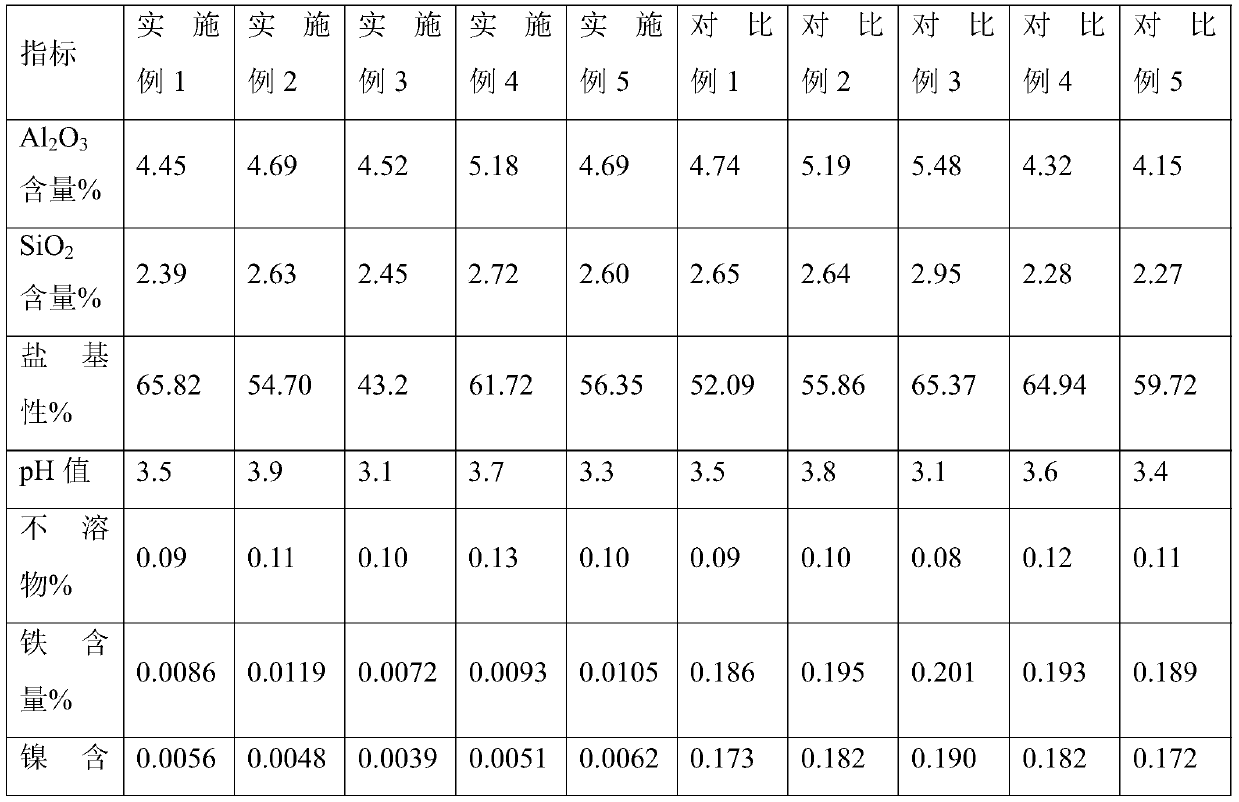Method for preparing polysilicate aluminum by using waste catalyst
A technology of waste catalyst and polysilicon aluminum, which is applied in the direction of chemical instruments and methods, aluminum silicate, silicate, etc., can solve the problems of secondary pollution of water quality, achieve the goal of increasing leaching rate, accelerating reaction rate and reducing production cost Effect
- Summary
- Abstract
- Description
- Claims
- Application Information
AI Technical Summary
Problems solved by technology
Method used
Image
Examples
Embodiment 1
[0052] (1) 230ml 32% sodium hydroxide solution and 100g FCC waste catalyst are mixed in a stainless steel autoclave, the stirring speed is set at 800 rev / min, and the electric heating is heated to maintain a reaction temperature of 140°C and a pressure of 0.42MPa. Alkali leaching reaction 2h. After the reaction is completed, it is transferred to a titanium rod filter while it is hot, and forced to filter under an air pressure of 0.6 MPa to obtain an aluminosilicate solution.
[0053] (2) Transfer the aluminosilicate solution to a three-necked flask, add 25% sulfuric acid solution dropwise under stirring to adjust the pH=1.2, consume 530ml of 25% sulfuric acid, control the reaction temperature in a water bath to 70°C, and add the solution for 40 minutes. After completion, it is matured for 1.5 hours to obtain a liquid polysilicon aluminum sulfate.
[0054] Detection of Al in filter residue 2 o 3 and SiO 2 content, calculate Al 2 o 3 The dissolution rate is 82.60%, SiO 2 ...
Embodiment 2
[0056] (1) Mix 130ml of 50% sodium hydroxide solution with 100g of FCC waste catalyst in a stainless steel autoclave, set the stirring speed at 800 rpm, heat up with electric heating, and keep the reaction temperature at 130°C and the pressure at 0.35MPa. Immersion reaction 1.5h. After the reaction is completed, it is transferred to a titanium rod filter while it is hot, and forced to filter under an air pressure of 0.5 MPa to obtain an aluminosilicate solution.
[0057] (2) Transfer the aluminosilicate solution to a three-necked flask, add 20% hydrochloric acid solution dropwise under stirring to adjust the pH=1.7, consume 595ml of 20% hydrochloric acid, control the reaction temperature in a water bath to 55°C, and add the solution for 30 minutes. After completion, it is matured for 1.5 hours to obtain a liquid polysilicon aluminum chloride.
[0058] Detection of Al in filter residue 2 o 3 and SiO 2 content, calculate Al 2 o 3 The dissolution rate is 81.72%, SiO 2 The ...
Embodiment 3
[0060] (1) Mix 410ml of 20% sodium hydroxide solution with 100g of FCC waste catalyst in a stainless steel autoclave, set the stirring speed at 1000 rpm, heat up with electric heating, and maintain the reaction temperature at 150°C and the pressure at 0.5MPa. Immersion reaction 1.5h. After the reaction was completed, it was transferred to a titanium rod filter while it was hot, and forced to filter under an air pressure of 0.4 MPa to obtain an aluminosilicate solution.
[0061] (2) Transfer the aluminosilicate solution to a three-necked flask, add 30% hydrochloric acid solution dropwise under stirring to adjust the pH=0.8, consume 363ml of 30% hydrochloric acid, control the reaction temperature in a water bath to 80°C, and add the solution for 60 minutes. After completion, ripen for 2 hours to obtain the finished liquid polysilicon aluminum chloride.
[0062] Detection of Al in filter residue 2 o 3 and SiO 2 content, calculate Al 2 o 3 The dissolution rate is 80.17%, SiO...
PUM
 Login to View More
Login to View More Abstract
Description
Claims
Application Information
 Login to View More
Login to View More - R&D
- Intellectual Property
- Life Sciences
- Materials
- Tech Scout
- Unparalleled Data Quality
- Higher Quality Content
- 60% Fewer Hallucinations
Browse by: Latest US Patents, China's latest patents, Technical Efficacy Thesaurus, Application Domain, Technology Topic, Popular Technical Reports.
© 2025 PatSnap. All rights reserved.Legal|Privacy policy|Modern Slavery Act Transparency Statement|Sitemap|About US| Contact US: help@patsnap.com



